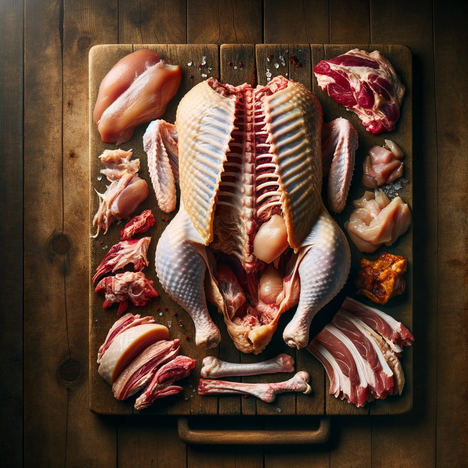Chicken backs

In the world of dog nutrition, natural food options are a big topic, with raw ingredients often at the center of the discussion. Chicken back, as part of the BARF (Biologically Appropriate Raw Food) concept, is gaining popularity. However, as with any food, there are pros and cons. In this article, you'll learn everything you need to know about chicken backs as part of your dog's diet.
What is chicken back?
Chicken back consists of the back part of the chicken, including the backbone, ribs and remaining meat. It is rich in protein and also contains fat, bone and cartilage. In raw feeding, it is prized for its balanced meat-to-bone ratio and nutritional content.
Benefits of chicken back in dog nutrition
Natural source of calcium and phosphorus
Bones are an excellent natural source of calcium and phosphorus, two minerals that are essential for building and maintaining strong bones and teeth in dogs. Chicken back offers a balanced blend of these minerals that may be superior to synthetic supplements.
Supporting dental health
Chewing on raw bones can help to mechanically clean teeth and reduce plaque, contributing to a dog's overall oral health.
Promoting digestive health
The cartilage and connective tissue in chicken backs can support gut health and contribute to regular digestive processes.
Disadvantages and risks
Potential for injury and blockages
One of the biggest disadvantages of raw bones, including chicken backs, is the risk of injury or blockages in the digestive tract. Bones can splinter and cause injury to the mouth, throat or along the digestive tract.
Nutritional imbalances
While chicken backing provides a range of nutrients, feeding it exclusively can lead to nutritional imbalances, especially if it is not combined with other nutrient sources.
Bacterial contamination
Raw chicken backs can be contaminated with bacteria such as Salmonella or Campylobacter, which can pose a health risk to both dogs and humans.
A balanced approach
Chicken backs can be a nutritious addition to your dog's diet, especially if you value natural raw feeding. However, it's important to consider the risks and take steps to minimize them. This includes only using chicken backs as part of a balanced diet that provides all the necessary nutrients. Also, pay attention to the origin of the chicken backs to reduce the risk of bacterial contamination. Responsible use of this food option can help ensure that your dog enjoys the benefits without the potential risks.
If you notice any signs of hypersensitivity or poisoning in your dog, you should see your vet immediately. We are not a substitute for a vet, but we try to be as accurate as possible. Every dog reacts differently and we recommend you get a second opinion or consult your vet if in doubt.
Stay healthy and take good care of your four-legged friend!😊